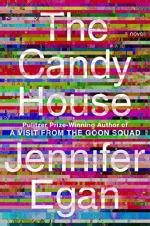|
This section contains 769 words (approx. 2 pages at 400 words per page) |

|
The Candy House Summary & Study Guide Description
The Candy House Summary & Study Guide includes comprehensive information and analysis to help you understand the book. This study guide contains the following sections:
This detailed literature summary also contains Quotes and a Free Quiz on The Candy House by Jennifer Egan.
The following version of this book was used to create the guide: Egan, Jennifer. The Candy House. Simon & Schuster, Inc., 2022.
Jennifer Egan's novel The Candy House is written from an assortment of different points of view. Each chapter presents a new narrative vantage and follows the life of a new character. The novel embraces experimental structural manipulations and uses the past and present tenses. The following guide adheres to the past tense. The below summary follows the basic trajectory of the novel's overarching plot line.
In "The Affinity Charm," Bix earned fame and fortune from his company Mandala. Mandala was born from Bix's dream of creating an online realm through which every human on Earth could connect. With Mandala, users could externalize their memories and upload them online. In this way, users could then experience and explore Mandala's Collective Consciousness. Despite his success, Bix had begun to feel disillusioned. What he really wanted was authentic connection and communication. He wondered if his work had merit, and began questioning its ethical implications.
In "Case Study: No One Got Hurt," throughout his life, Alfred had been frustrated with human inauthenticity. In order to elicit authentic behaviors from people in his general sphere, he began staging public screaming fits. The reactions of passersby, Alfred believed, evidenced their true characters.
In "A Journey: A Stranger Comes to Town," Miles discovered that his wayward cousin Sasha had achieved artistic success. Baffled by her story, Miles contacted her, asking if he could come to California to see her work. Sasha agreed to host him, much to her husband Drew's chagrin. When Miles arrived, Drew took him on a hot air balloon ride to view Sasha's massive sculptures from the sky. Overwhelmed by his insignificance, Miles tried to throw himself out of the basket. Drew saved his life.
In "Rhyme Scheme," Lincoln worked for a company called Harvest where he met a girl named M. Confused by his overwhelming attraction to M, Lincoln endeavored to use equations to logically explain it. He eventually realized that the human mind and heart often functioned outside of reason.
In "The Mystery of Our Mother," twins Lana and Melora were always close. After their father Lou left their mother Miranda for a younger woman, the girls' connection with Miranda strengthened. Years later, Lou resurfaced in the twins' lives. Their mother devoted herself once again to her anthropological career, traveling overseas. Meanwhile, the twins lived with and grew close to Lou. Over the years, the sisters' relationship dissolved for reasons Melora longed to understand.
In "What the Forest Remembers," Charlie poured over her father Lou's Mandala data in order to better understand her past. Some of the data disturbed her, but in time it granted her clarity.
In "Bright Day," Roxy attended Dungeons & Dragons group sessions at her treatment center, Bright Day. She liked the sessions because she liked the leaders, Chris and Molly. Meanwhile, Roxy waited for her Mandala box to arrive so she could externalize her memories and relive happier days.
In "i, the Protagonist," after working for a company called SweetSpot Networks for some time, Chris became disillusioned. He began to realize that social media users needed someone to protect their privacy. He developed Mondrian in order to protect such users.
In "The Perimeter: After," Molly spent the majority of her childhood at the Country Club. Though she had friends, they were often unkind to her. Things began to change when a new girl, Lulu, arrived at the club.
In "Lulu the Spy, 2032," Lulu abandoned her life and identity in order to act as a Citizen Agent. As an agent, she was given a Designated Mate, a criminal about whom the government wanted information. After her mission, Lulu felt lost and paranoid.
In "The Perimeter: Before," when Noreen's neighbor's brother, Jules, moved in next door, Noreen became anxious. She and Jules began a fight over the property line which eventually evolved into friendship.
In "See Below," Lulu became desperate to meet her estranged father, movie star, Jazz Attenborough. Orchestrating a meeting with him distracted him from her paranoia and gave her a sense of purpose.
In "Eureka Gold," after finishing his MFA, Gregory felt alone and lost. He visited his former professor for advice, and she told him to complete his book. After leaving her house, Gregory had an epiphany which opened him to the beauty of the world.
In "Middle Son (Area of Detail)," because Portia knew her middle son Ames was often overlooked, she tried to give his life a shape. Lending his life a narrative structure granted it depth and meaning.
Read more from the Study Guide
|
This section contains 769 words (approx. 2 pages at 400 words per page) |

|



